Agave polianthiflora, first. Then A. toumeyana var. toumeyana.
Bob
Comments
Re: some agaves
If you live in a place where you have no idea what "winter wet" means, then I guess they're hardy to about -25C.
It never rains in the winter here. "Never" as in the same sense that I "never" worry about the garden being trampled by elephants.
These are growing in very sandy soil.
But, look at the winter damage on Agave toumeyana var. bella, growing about 20cm away from A. toumeyana var. toumeyana. It might have had it little tips sticking above the snow when it got really cold, and I don't usually go outdoors then, to check agave tips (or anything else). It does have at least one nice looking pup on the other side, though.
Both plants about ten years old, I think.
Bob
Re: some agaves
Bob
It looks like the difference between survival or death is reliable snow cover during cold snaps.We get down to 10f during the winter but the snow doesn't last for more than a day. We are in a constant freeze thaw cycle most of the winter. Average moisture is only six inches with ninety percent accumulating in the winter.
I do grow several other agave.
Photo #1 is Agave utahensis var. utahensis I also grow it's varieties v. nevadensis, v. kaibabensis, and v. eborispina
Photo #2 is Agave palmeri
Photo #3 is Agave parryi
Photo #4 is Agave ovatifolia
Re: some agaves
Bob, what is that cactus growing just to the left of Agave toumeyana var. bella?
Re: some agaves
what is that cactus growing just to the left of Agave toumeyana var. bella?
Coryphantha echinus. There are two of them there, but one is hidden in the buffalograss.
Bob
Re: some agaves
It looks like the difference between survival or death is reliable snow cover during cold snaps.
Or the brevity of the cold snap ..... It doesn't stay really cold (below 0F, -17C) here for that long (the wind, which is up right now, blows all the cold air into Denver and points east...I don't even usually acknowledge wind that's less than 75 mph, those are just gentle zephyrs), but it is cold, ie. below freezing, almost every night from this time of year until mid-February. But dry.
I'm trying Agave palmeri this year, and so far, it's fine. That will probably change in the next month or so. (The period right before Christmas often brings us the lowest temperatures of the year.)
A. parryi has formed a large colony in the back, and A. parryi var. huachucensis has been in the front yard for years. I forgot it was there umtil I kneeled on it this summer while weeding.
I also picked up a number of neat forms of agaves from Cistus this year, but they're overwintering upstairs. I find that agaves and dasylirions and nolinas need to be planted out early in order to acclimatize.
Bob
Re: some agaves
A. parryi var. huachucensis has been in the front yard for years. I forgot it was there until I kneeled on it this summer while weeding.
Och!! That had to draw blood. :o
I hope you marked it's location for further reference.
I find that agaves and dasylirions and nolinas need to be planted out early in order to acclimatize.
I agree they need summer heat to develop a strong, extensive root system.
Re: some agaves
Here is Dasylirion (I know, not an agave, but close) texanum. First shot in the back yard, second, in the front yard, protected from rabbits. I know, the chicken wire is so attractive.
The front yard plant has been there 10+ years, but who knew that rabbits would eat all the leaves to get to the pineapple-like core? They killed a whole large plant that way. (Rabbits will also eat agaves.)
Plantskydd will keep them away but I forget to sprinkle it.
Now, riddle me this, as they say. D. texanum is apparently completely hardy in Denver. But it never experiences temperatures colder than, say, 10F (about -12C), in its native habitat. There are no "cold hardy" selections of D. texanum in the trade, it's just the typical plant.
D. leiophyllum grows in southeastern New Mexico in a colder climate but is said not to be hardy here. (It also integrades or hybridizes with texanum where the two species meet...this is sometimes called D. hamatacanthum.)
There is a population of D. wheeleri growing in the lava beds north of Carrizozo, NM (lowest recorded temp -17F, about -27C), and these are also said not to be hardy in Denver.
Does this make sense to anyone?
I was offered a plant of leiophyllum the size of a small car, but had nowhere to plant it (except next door, and I didn't want my neighbor to have one if I didn't ......). I am growing several Carrizozo wheeleri indoors for planting when they get bigger, just to see if this is really true.
Bob
Re: some agaves
Bob
It sounds like a riddle indeed. ;)
I guess we all know, plant hardiness is a somewhat subjective designation. So many factors involved it is often not clear cut.
I will be interested to hear the results of your experiment. I have tried a Dasylirion (not sure which it was, the key word is was!! :rolleyes:) it just turned up it's toes and died. They get a little too large for the space I have left, so I moved on and planted a cylindropuntia in it's allocated spot. It is doing fine and likes the care it's receiving. ;)
I was offered a plant of leiophyllum the size of a small car, but had nowhere to plant it (except next door, and I didn't want my neighbor to have one if I didn't ......).
Understandable and the only right course of action to take, in my opinion. ;)
Re: some agaves
Agave parryi out of control.
The small oval green leaves are Scutellaria salviifolia, which, no matter how much I hate it, or weed it, keeps coming back. Lots of fun to weed around the agaves.
Dead looking stuff in the middle is Phlox alyssifolia. The white sticks everywhere are Oenothera neomexicana ssp instantaneo-ubiquituus.
Bob
Re: some agaves
Oenothera neomexicana ssp instantaneo-ubiquituus.
Bob
Good One!! ;) I think I've seen that ssp. moniker listed on several other genera also. :rolleyes:
Re: some agaves
Agave parryi out of control.
The small oval green leaves are Scutellaria salviifolia, which, no matter how much I hate it, or weed it, keeps coming back. Lots of fun to weed around the agaves.
Dead looking stuff in the middle is Phlox alyssifolia. The white sticks everywhere are Oenothera neomexicana ssp instantaneo-ubiquituus.Bob
Nice agave, looks very much like my parryi. I dont know if it is as hardy yours wow. ;)
Re: some agaves
I think all parryis are equally hardy. Parryi var. parryi, var. couesii, var. truncata, var. huachucensis.
The reason I think this is that plants with proven hardiness (the A. parryi in Kelly Grummons' garden, pictured in High and Dry, was collected by Mary Ann Heacock near Flagstaff....probably south of it where Alan Bradshaw collected his....in the 1950s) don't come from climates as cold as Denver's, so there doesn't seem to be any real relationship between where the plant grows and its ability to endure cold below 0F (-17C).
Kelly is now recommending "full sun all day" which I think is an excellent prescription, to which I would add "out of the wind" (in other words, not in my garden) and "totally dry".
As Gentry said, "agaves in Section Parryanae are mesophytes in their native habitat", but as the temperature drops below that experienced in their native habitats, soil moisture seems to be critical for survival.
I did manage to kill var. truncata by not having it dry enough or in enough sun during the winter (and this was a piece from the original plant descried by Gentry ....), but huachucensis shows no difference (here) in hardiness from regular parryi. One of the plants in the group pictured above is huachucensis, and here's another, in the front yard, that has too much stuff growing around it, but it's been here for at least ten years.
Bob
Re: some agaves
Good info thanks. :)
Re: some agaves
Well, info, anyway.
Agave havardiana is supposed to be the hardiest agave (I disagree; I say it's A. utahensis; it doesn't get to twenty below in Texas). People say that the bigger the plant, the better its chances. (My observation is that little, seed-grown plants have no chance at all.)
Uh, the larger the plant, the higher the price.
So here are a couple of pictures of part of the front yard, that I just took, displaying a total lack of financial discretion.
Bob
Re: some agaves
Oh, and a self sown snapdragon.
Bob
Re: some agaves
I've not had great success with the hardier agaves, due to our soggy winters. Even with cover they don't prosper. Possibly bigger plants would be more adaptable, but I've only tried young plants grown from seed. However, I am really pleased by several dasylirions, which I imported from Yucca Do Nursery. At least in the sand bed these have prospered and not been damaged in our protracted cold last winter. I've only seen them before on Tresco (Isles of Scilly), where they make marvellous 'fibre optic' like clumps. Great plants.
Re: some agaves
English gardens are not supposed to look like that!
(Okay, yes, they are. The first thing I think of when I think of Yucca is Wm. Robinson's encomium in The English Flower Garden.)
Bob
Re: some agaves
Bob - I have a certain eccentricity and am not sure what a garden should look like! What I like most is collecting and propagating plants and trying to convince other gardeners they are worth growing!
Re: some agaves
I have a certain eccentricity and am not sure what a garden should look like!
It's funny that people on this side of the Atlantic talk about the "English garden" as though it were something that could be fixed in the imagination. I suspect they mean Sissinghurst.
Add Logan and Tresco and you have a very different picture, don't you?
And I'm constantly reminded that Farrer grew a lot of western North American plants long before we did.
There's a pretty funny story in Weber about Jamesia americana too.
Bob
Re: some agaves
I've not had great success with the hardier agaves, due to our soggy winters. Even with cover they don't prosper. Possibly bigger plants would be more adaptable, but I've only tried young plants grown from seed. However, I am really pleased by several dasylirions, which I imported from Yucca Do Nursery. At least in the sand bed these have prospered and not been damaged in our protracted cold last winter. I've only seen them before on Tresco (Isles of Scilly), where they make marvellous 'fibre optic' like clumps. Great plants.
Those look great! Nice plants. 8)
Re: some agaves
I thought about moving to Arizona so I could grow more dasylirions, but now I wonder if i shouldn't move to England .....
Bob

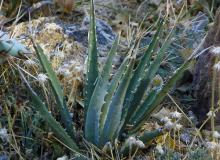
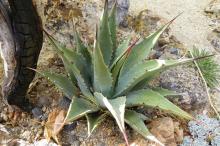
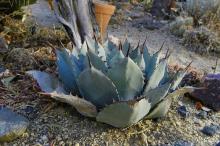
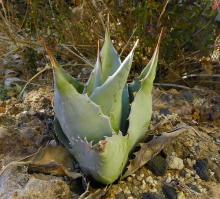
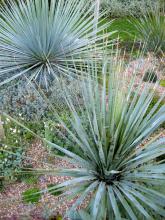
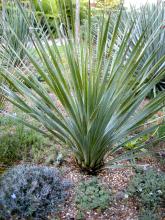
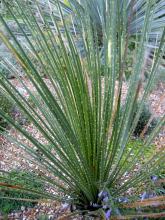
Bob
I have never tried polianthiflora. It looks happy in your garden. Do you protect it in the winter? From what I read it is native to northern Mexico at high elevation.
I did try A. toumeyana var. bella two years ago but it didn't make it through the winter. Is there a secret incantation or other magical concoction I should be using? :rolleyes:
I planted it in late spring on a very well drained, sandy medium. It was looking good in the fall as it had put on new leaves by late summer. But alas it is no more. :(